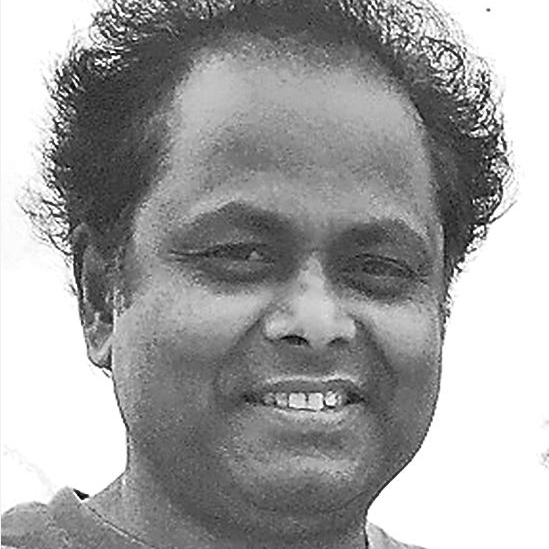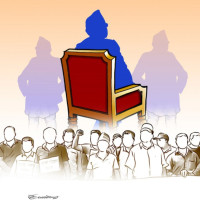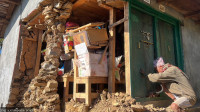Opinion
The language debate
Both Sanskritic conservatism and speech-based vernacular-nationalism fall short of the need of the hour
Pramod Mishra
The controversy surrounding spelling (tatsamikaran or tadbhavikaran) in the Nepali language sounds like a storm in a teacup or the Mary Antoinette syndrome—“are people starving for bread? Why? Give them cake!” Both the Sanskritists (tatsamwadis) and the vernacular-nationalists (tadbhavbadis) have either missed the point of discussing the nature of the Nepali language in the post-2006 Nepal or have been Rip-Van-Winkled with a dose of Khas cultural nationalism into sleep amnesia. This is so because rather than trying to justify whether speech or convention of writing (from Sanskrit) ought to guide how Nepali is to be spelt, Nepal’s learned linguists, subject committee officials or Nepal Academy scholars should be devoting their time to this question: how can Nepal’s linguistic conundrum be resolved to suit its multilingual, multicultural, and multiregional communities? Where does Nepali (not long ago called Khas Kura) stand confronted as it is by the challenges that the Madhesis and Janajatis pose by demanding an official and structural recognition of their languages? How can this state engineered, nurtured and imposed speech of a single community rise to include Nepal’s myriad linguistic communities?
Of all these disquisitions in the media, only Yug Pathak’s long, admirably analytical and historically informed piece questions the relevance of this debate but still takes for granted that Nepali is the lingua franca of Nepal, which it is not. To be sure, Nepali indeed works as a lingua franca when a Nepali-speaker speaks the language with either another Nepali speaker or a non-Nepali speaker who knows the language. In the hills, even a non-Nepali speaker who has been in contact with the national conversation in Nepali uses the language with another Janajati member of a different linguistic group—say a Thakali or Gurung or Magar speaker communicating with a Rai or Limbu speaker. But in the Tarai, even a Nepali speaker, once out of his linguistic zone among Tarai language speakers, especially in the villages and Madhesi towns, speaks in broken Hindi. The status of Tarai Janajatis is complex. They communicate both in Nepali and Hindi depending on their interlocutors or place where they find themselves. Closer to the East-West Highway, they speak in Nepali; closer to the Nepal-India border, they speak in Hindi and their mother tongues. The gender dimension makes even this simple configuration much more complex for reasons of female literacy and exposure to the outside world.
Khas Kura
A number of scenarios emerge at present to resolve Nepal’s linguistic conundrum, which in my view is the most serious and complex problem for structural inclusion.
What we know as Nepali now took its name by fiat of the Gorkhali conquerors/unifiers. Historical linguists know that not long ago, it was called Khas Kura or even Gorkha Bhasa. One option could be to change its name back to its old name, Khas Kura, to take the wind out of the sail of the language nationalists and provide them a clearer perspective of the past and the future. Once Nepali again begins to be called Khas Kura, then the country can begin a conversation about its usefulness and stifling power. Call it Nepali or Khas Kura, once the language of a small community of hill caste Hindus of central and eastern mid-hills has spread over far and wide as a result of state protection and promotion, why lose this already available resource if its dominating power can be neutralised?
The narrow focus of the linguists and language power holders is out of place also because if the Sanskritists favour the discipline or purity (sanskar) of Brahmanic tradition, the vernacularist-nationalists (the jharrobadis) began their Jharrobad movement in the 1970s consciously or unconsciously inspired by the Panchayat ideology of soil-suitable polity. These “slangists” privileged raw, colloquial expressions as pure Nepali over borrowings from either Sanskrit or other languages, such as English.
You can read veteran linguist and one of the Jharrobadi leader Bal Krishna Pokhrel’s piece on Setopati, “No Need for Linguistic Extremism Now,” in which he justifies his and his Jharrobadi group’s movement against “kyuki-balki” and “agar-magar” influences of Hindi. He even names English and Urdu as threats to Nepali and takes pride in the fact that he and his colleagues of the movement saved Nepali from these influences. Now, however, he and his fellow Jharrobadi Tara Nath Sharma argue for moderation, even conservatism, because they believe Nepali has attained maturity and strength. While they went along with soil-suitable ideology of Panchayat in the field of language, in the age of diversity, multilingualism, republicanism and federalism, instead of envisioning a new future of radical hybridisation and boundary-breaking, Pokhrel is advocating linguistic conservatism.
Thus, both Sanskritic conservatism and speech-based vernacular-nationalism fall short of the need of the hour. If the former closes the door for innovation, the latter fails to break the narrow self-obsession of descriptive linguistics in spelling and state-sponsored academic and institutional monolingual determination.
Two possible solutions
The way forward to address the linguistic necessities of a multilingual and globally intertwined Nepal needs to be addressed with the audacity of a revolutionary rather than the paranoia of a reactionary. If Nepali is to rise above its Khas Kura status, it needs to embrace the multitudes like Bahasa Indonesia, a reconstructed language out of Malay, Dutch, Javanese and other languages in independent Indonesia. We should remember that Javanese was the largest linguistic group (above 40 percent) at the time of Indonesia’s independence but the Indonesian visionaries, confronted with the enormity of the country’s linguistic and ethnic diversity, chose to enlarge and reconstruct Bahasa Indonesia out of a number of languages to foster a feeling of inclusion among Indonesia’s myriad groups.
The other option, of course, is to open the door for many languages, including mother tongues and English and Hindi, depending on the region and the kind of use while retaining a broadly conceived Nepali as the language of legal documents. But what the linguistic minds and institutions of Nepal cannot do is to keep the boundary of thinking confined to the same old ways of one language Sanskritism or vernacular-nationalism.




 17.12°C Kathmandu
17.12°C Kathmandu










